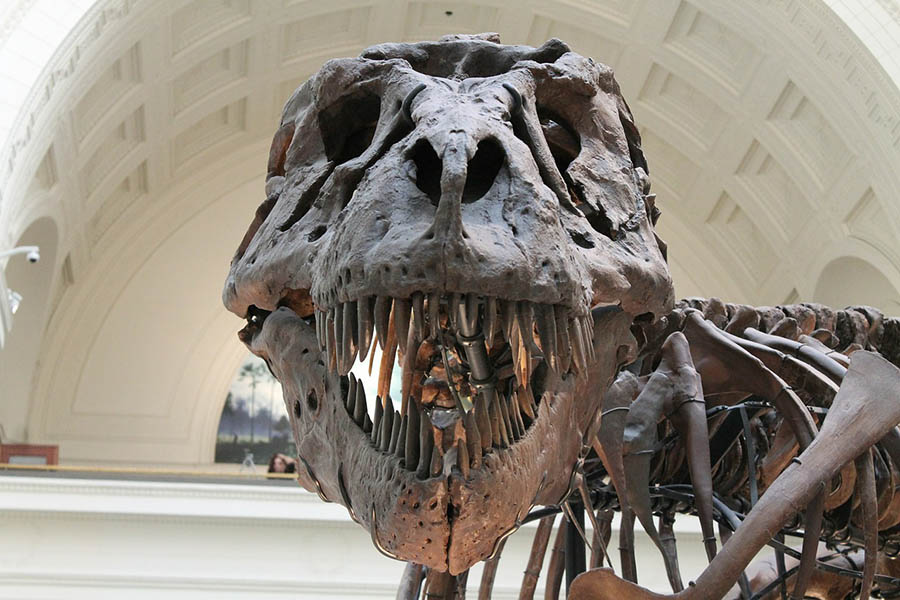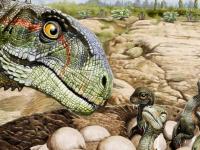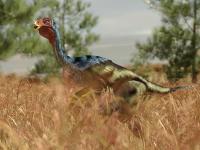25 Fascinating Facts About Fossils

From giant parrots and feathered dinosaurs to really old poop and The Bone Wars to the difference between body fossils and trace fossils, here are some fun facts about fossils, adapted from an episode of The List Show on YouTube.
1. A FOSSIL SHOWED THAT PARROTS USED TO BE 3 FEET TALL.
In 2019, a paper published in the journal Biology Letters described the fossil of a parrot that lived somewhere around 16 to 19 million years ago. The bones were originally found in 2008, but they were misidentified as an eagle because no one assumed there would be a parrot that big. The bird, believed to be about 15 pounds, is now affectionately referred to as “squakzilla.”
2. THERE ARE REQUIREMENTS THAT NEED TO BE MET FOR SOMETHING TO BE CONSIDERED A FOSSIL.
Fossils are generally defined as the preserved remains, traces, or imprints from an organism. The common definition also requires that it be 10,000 years or older.
3. THERE ARE A FEW TYPES OF FOSSILS.
When we think of fossils, most of us probably picture animal bones or teeth. These are known as body fossils. But there are also trace fossils, which are evidence of an animal’s behavior: things like footprints, nests, eggs, and even poop.
4. THE MEANING OF THE WORD FOSSIL HAS CHANGED.
The word fossil can be traced to the Latin term fossus, which means “dug up.” That was also fossil’s original meaning when it emerged around the 1600s. It began to mean “preserved remains” in 1736.
5. THERE'S SUCH A THING AS "MICROFOSSILS."
It’s not always easy to determine what a fossil used to be. Microfossils are fossils of bacteria or pollen, or other things that you can’t study with the naked eye. In 2017, paleobiologist J. William Schopf and a team published a paper about the microfossil microbes he found in the early '90s. Schopf claimed these rocks showed evidence of microbes from 3.46 billion years ago, which would have made them, at that time, some of the oldest fossils ever found. Not everyone was convinced; some said the so-called fossils were just minerals that happened to look like biological specimens. Schopf and his collaborators worked for almost 25 years to prove that the rocks contained the right carbon isotopes to have once been microbes, and their 2017 paper provided what some in the field felt was compelling evidence, using raman spectroscopy to analyze the specimens in question.
Skeptics remain, though, including scientist David Wacey, who had issues with both the accuracy of the methods Schopf used and with the peer review process which led to the paper’s publication. Wacey, for his part, was part of the team that discovered evidence for a different microfossil that once claimed the title of oldest discovered fossil.
6. IT CAN TAKE A LONG TIME TO DIG UP FOSSILS.
Procuring the fossils can feel endless. For example, in 1989, William Zinsmeister found the fossil of an estimated 15-ton, 40-foot-long elasmosaur, which is a Plesiosaur that basically looks like a sea monster. But he found it on Seymour Island in the Antarctic, where excavating isn’t easy. Teams could only work for a few weeks out of the year and only when they had the financial resources. Excavation wasn’t complete until 2017.
7. WE'VE BEEN FINDING FOSSILS FOR A LONG TIME.
Humans have been discovering fossils—and even using them—since very early in our history. At least one member of the Homo heidelbergensis species (one of our ancestors from hundreds of thousands of years ago) created an axe that prominently featured a fossilized sea urchin.
8. FOSSILS MIGHT HELP EXPLAIN ANCIENT MYTHOLOGY.
People found fossils throughout history and didn’t really know what they were, which might help explain some ancient mythology. The Ancient Greeks believed in Cyclopes. One popular explanation why? Ancient elephants once roamed the area. The empty space in their skull where the trunk would go, when found by an ancient person, might have looked like the perfect spot for a single eye.
9. WE ONCE BELIEVED MAMMOTH AND MASTODON FOSSILS WERE THE BONES OF GIANTS.
There are many stories of people finding the large bones from creatures like mammoths and interpreting them as having once belonged to giant humans. In 1712, Puritan minister Cotton Mather (of Salem Witch Trial fame) professed in a letter to the Royal Society of London that parts of a mastodon skeleton were evidence that there were giants in the Americas, and that those giants were taken out by the flood described in the Bible.
10. THE FIRST DINOSAUR FOSSIL WAS FOUND AROUND 1815.
The first identified dino fossil belonged to a Megalosaurus. An array of its bones, including a large lower jawbone, were found around 1815, but it wasn’t until 1824 that William Buckland published an article describing their previous owner as a reptile or “great fossil lizard.”
11. ONE FOSSIL WAS BELIEVED TO BE A HOAX.
A few decades later, an Archaeopteryx fossil was found, which contained both feathers and teeth—an unusual combination. Thomas Henry Huxley, certainly inspired by Charles Darwin’s recently published On the Origin of Species, was the first to claim that dinosaurs and birds were relatives. In 1985, this fossil made headlines again when British astronomer Sir Fred Hoyle and five other scientists claimed that the fossil, then sitting in the British Museum of Natural History, was a fake—that the feathers were pressed into stone in modern times. But the museum has since proven those accusations false. Because the fossil was preserved inside of limestone, there are two matching halves to it. Technology can help show that the halves are identical, which wouldn’t be possible if it were human-made.
12. A FOSSIL OF A NON-AVIAN DINOSAUR WITH FEATHERS WAS FOUND IN 1996.
The dino was Sinosauropteryx. The feather impressions—also called dinosaur fuzz—contain preserved melanosomes, which helps determine what colors certain dinosaurs were. Experts believe that Sinosauropteryx had a red and white tail.
13. SOME FEATHER FOSSIL COLORS ARE HARD TO IDENTIFY.
We've also discovered that the Anchiornis had black and white feathers with some red on its head, and the Ichthyosaur had dark skin. Unfortunately, this method can’t be used for all dinosaurs. Some colors, like yellow, are produced through different pathways, and they’re harder to identify.
14. IN 2019, SOME PALEONTOLOGISTS PUBLISHED A PAPER ABOUT THE DAY THE DINOSAURS WENT EXTINCT.
Working in Hell Creek Formation in North Dakota, they discovered fossils of fish, who were part of the 75 percent of the earth’s plant and animal species wiped out that day. Hell Creek is about 2000 miles from where the asteroid struck that caused this destruction. And yet the researchers claimed that it led to big enough waves in this particular river valley that many fish became buried under sediment. Some even had rock, which had supposedly rained down from the sky, in their gills. This research isn’t a sure thing, though, and some geologists argue that Hell Creek could have experienced these geological changes without it necessarily having to do with that asteroid.
15. FOSSILIZED POOP CAN BE PRICEY.
Trace fossils are a great way to learn about how extinct animals behaved. Studying fossilized feces, also known as coprolite, is an important part of paleontology. And some people are just fascinated by it. For instance in 2014, a collector bought a 40-inch coprolite at an auction for over $10,000. That may have been a mistake: It came from a formation in Washington State where similar items have been studied and were actually just the mineral siderite.
16. SOME FOSSIL-FINDERS HAVE FUN NAMING THEIR DISCOVERIES.
In 1985, Australian scientists discovered the fossil of an ancient python in Riversleigh, Queensland, Australia, which they named Montypythonoides riversleighensis. Despite the apparent connection to the British comedy legends, the official explanation for the name claimed that it was because “it was found on a small hill or monti” and was broadly like present-day pythons. Sadly for us comedy fans, it was later renamed Morelia riversleighensis.
17. ONE ANCIENT MAMMAL WAS NAMED FOR A ROCKER.
In 2014, a species from 19 million years ago was discovered. It was a mammal, related to the hippopotamus we know today, and it had large lips—so one of its discoverers, Ellen Miller, named it the Jaggermeryx naida, or “Jagger’s water nymph,” after none other than Mick Jagger.
18. LUCY WAS NAMED AFTER A BEATLES SONG.
Lucy lived 3.2 million years ago and was found in 1974. At the time of her discovery she was the earliest and most complete skeleton of an ancient hominin. Donald Johanson was the first to see her bones in Ethiopia and that night, his team was listening to a Beatles cassette when one of them suggested her name, inspired by the song “Lucy in the Sky with Diamonds.” (For the record, we now have remains of much older hominins than Lucy.)
19. ONE FOSSIL WAS DISCOVERED WITH 38 OFFSPRING.
In 2018, we learned about an exciting mammalian relative that reproduced more like a reptile than a modern mammal. Researchers Eva Hoffman and Timothy Rowe found the skeleton of a K. wellesi that was buried with at least 38 offspring, which is considerably more than modern mammals have in a litter.
20. A FOSSIL SKULL BELONGING TO A BIG CAT WAS DISCOVERED IN 2010.
Another exciting fill-in-the-gap discovery was the Panthera blytheae in 2010. This was the skull of a big cat, a relative of the snow leopard, which showed that big cats actually lived around 6 million years ago, earlier than previous fossil evidence had indicated. It also showed that big cats evolved in Asia when it had been thought that they evolved exclusively in Africa.
21. WE KNOW ABOUT ANCIENT TICKS THANKS TO FOSSILIZED RESIN.
Another interesting type of fossil is fossilized resin or amber. Many trees contain resin, which can turn into fossils, and when there are critters inside, we can learn about their ancient lives too. For instance, in 2017, a paper was published showing that ticks used to suck the blood of dinosaurs. Scientists already knew that ticks existed back then, but figured they went after other animals. But fossilized amber was found containing a tick from 99 million years ago holding onto a dinosaur feather.
22. THANKS TO FOSSILS, WE KNOW THAT SOME CROCODILE RELATIVES WERE HERBIVORES.
Fossil records can demonstrate the incredible diversity of life on our planet, like the fact that some crocodile relatives were actually herbivores. A different crocodilian was only 20 inches long, and so mammal-like that it was named "cat crocodile."
23. A CONSTRUCTION WORKER FOUND A 110-MILLION-YEAR-OLD FOSSIL AT A WORK SITE.
In 2011, construction worker Shawn Funk found the skeleton of a 110-million-year-old dinosaur at a work site in Alberta, Canada. This Borealopelta was a victim of what experts call “bloat and float.” The animal dies, which causes it to bloat with gases, then it floats through water until it loses that gas and sinks. But 1.5 tons of dinosaur sinking causes quite the disturbance, so this Borealopelta got covered in sediment, preserving it amazingly.
24. FOSSILS LAUNCHED WHAT CAME TO BE KNOWN AS THE BONE WARS.
The Bone Wars took place in the late 19th century. Many paleontologists were rushing to identify and name a bunch of dinosaur species, including notably Edward Cope and Othniel Marsh. Marsh named the Apatosaurus in 1877 and the Brontosaurus in 1879. Then in 1903, paleontologist Elmer Riggs officially stated that this was the same genus, so the Brontosaurus was an Apatosaurus (because the first to be named keeps its name). But then, in 2015, a 300-page study was published that examined 81 sauropods. Though it wasn’t the original intention of the study, it concluded that the Apatosaurus and Brontosaurus are indeed different enough to be considered separate animals. It claimed, amongst other differences, that the Brontosaurus has a higher, thinner neck. Not every paleontologist subscribes to this distinction, though.
25. ONE ANCIENT PENGUIN PREDECESSOR WAS OVER 5 FEET TALL.
In 2018, a fossil of the Crossvallia waiparensis was discovered in New Zealand. This prehistoric penguin lived between around 56 and 66 million years ago, and based on the skeleton, researchers determined that it was about 5 foot 3 inches tall. It's one big bird, but it's not the tallest penguin predecessor in history: Palaeeudyptes klekowskii could have been 6 foot 5.
Source: www.mentalfloss.com/








